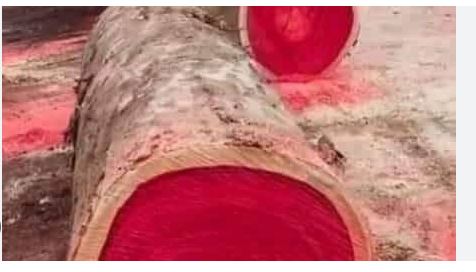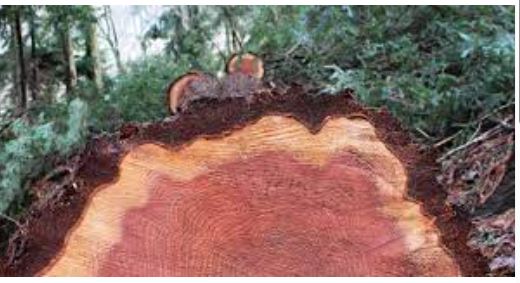
Trees with red wood are prized for their striking heartwood, ranging from vivid crimson to deep reddish-brown, found in both temperate and tropical regions across North America, South America, Africa, and Australia. Spanning hardwoods and softwoods, these species thrive in diverse climates, from coastal zones to humid tropics, typically in USDA zones 3-12.
Historically, these trees have been valued for centuries by indigenous cultures and artisans for their durable, colorful wood, used in everything from construction to intricate carvings. Early uses included tools, shelters, and ceremonial items, with some species providing edible fruits or medicinal extracts.
Characteristically, these trees vary from small ornamentals (15-30 feet) to towering giants (over 200 feet), with foliage ranging from needle-like to broad leaves. Many feature vibrant flowers or fruit, supporting wildlife, while their wood is often strong, decay-resistant, or aromatic. Fall foliage in deciduous species adds seasonal brilliance, enhancing their landscape appeal.
Uses include premium timber for furniture, flooring, and musical instruments, as well as ornamental planting for shade, windbreaks, or aesthetic focal points. Ecologically, they support pollinators and birds, but some face conservation challenges due to overharvesting or invasiveness.

Trees With Red Wood
Redwood (Sequoia sempervirens)
The Coastal Redwood, native to California and southern Oregon, is a towering evergreen (up to 380 feet) with reddish-brown heartwood prized for its durability and resistance to decay. Its soft, fibrous bark, needle-like leaves, and small cones are distinctive. Thriving in USDA zones 7-9, it prefers foggy, coastal climates with moist soils. The wood is widely used for outdoor furniture, decking, and siding, while its majestic stature makes it a conservation icon in protected forests.
Western Red Cedar (Thuja plicata)
Western Red Cedar, native to the Pacific Northwest, grows to 150-200 feet with aromatic, reddish-brown wood valued for shingles, siding, and boat building. Its scale-like leaves and small, woody cones add ornamental appeal. Thriving in zones 5-8, it prefers moist, well-drained soils in partial shade. The wood’s natural preservatives ensure longevity, making it a top choice for outdoor applications, while the tree is culturally significant to Indigenous peoples.
California Redwood (Sequoia gigantea)
Also known as Giant Sequoia, this massive evergreen (up to 300 feet) is native to California’s Sierra Nevada. Its reddish heartwood is strong and decay-resistant, used for construction and fencing. Featuring thick, spongy bark and scale-like leaves, it thrives in zones 6-8 in well-drained, sunny sites. Its grandeur makes it a focal point in parks, though its wood is less harvested today due to conservation efforts.
Bloodwood (Brosimum rubescens)
Bloodwood, native to Central and South America, is a tropical hardwood (50-100 feet) with vivid red heartwood used for fine furniture, veneers, and decorative inlays. Its small, glossy leaves and inconspicuous flowers suit tropical landscapes. Thriving in zones 10-12, it prefers humid, well-drained soils. The wood’s intense color and durability make it a premium choice for artisans, though sustainable sourcing is critical due to deforestation concerns.
Red Mahogany (Eucalyptus resinifera)
Red Mahogany, native to eastern Australia, is a tall hardwood (up to 150 feet) with deep red, durable wood used for flooring, furniture, and structural timber. Its lance-shaped leaves and white flowers attract pollinators. Thriving in zones 9-11, it prefers well-drained soils and full sun. The wood’s strength and rich hue, combined with the tree’s fast growth, make it a valuable timber and ornamental species.
Padauk (Pterocarpus soyauxii)
African Padauk, native to Central and West Africa, grows to 100-130 feet with bright red-orange heartwood that darkens over time, ideal for furniture, musical instruments, and veneers. Its pinnate leaves and yellow flowers add tropical flair. Thriving in zones 10-12, it prefers humid, sunny conditions. The wood’s vibrant color and workability make it a favorite for high-end craftsmanship, though overharvesting requires sustainable management.
Redheart (Erythroxylum spp.)
Redheart, native to Central and South America, is a small to medium hardwood (30-60 feet) with striking red heartwood used for decorative items, turnery, and inlays. Its small, green leaves and inconspicuous flowers suit tropical gardens. Thriving in zones 10-12, it prefers well-drained, sunny sites. The wood’s vivid color and fine grain make it a specialty timber, though limited availability calls for careful sourcing.
Bubinga (Guibourtia demeusei)
Bubinga, native to Central and West Africa, is a large hardwood (80-150 feet) with reddish-brown wood, often figured, used for luxury furniture, cabinetry, and musical instruments. Its broad leaves and small flowers support tropical ecosystems. Thriving in zones 10-12, it prefers humid, well-drained soils. The wood’s strength and rich color, paired with its versatility, make it a premium choice, though conservation is key due to high demand.
Sapele (Entandrophragma cylindricum)
Sapele, native to West and Central Africa, grows to 100-150 feet with reddish-brown, interlocked-grain wood used for furniture, flooring, and boat building. Its lance-shaped leaves and small, yellowish flowers are subtle but attractive. Thriving in zones 10-12, it prefers tropical, moist conditions. The wood’s durability and lustrous red hue make it a mahogany substitute, widely sought after in high-end woodworking.
Red Oak (Quercus rubra)
Northern Red Oak, native to eastern North America, reaches 60-80 feet with reddish-brown heartwood used for furniture, flooring, and barrels. Its lobed leaves turn vibrant red in fall, enhancing landscapes. Thriving in zones 3-8, it prefers well-drained, acidic soils. The wood’s strength and warm color, combined with the tree’s shade and fall beauty, make it a staple in forestry and ornamental planting.
Cherry (Prunus serotina)
Black Cherry, native to North America, is a medium-sized deciduous tree (50-80 feet) with reddish-brown wood prized for fine furniture, cabinetry, and veneers. Its glossy leaves, white flower clusters, and edible black cherries are notable. Thriving in zones 3-9, it prefers fertile, well-drained soils. The wood’s rich color, which darkens with age, and the tree’s ornamental qualities make it a dual-purpose species.
Cocobolo (Dalbergia retusa)
Cocobolo, native to Central America, is a small to medium hardwood (30-60 feet) with vibrant red-orange wood used for knife handles, musical instruments, and luxury turnery. Its small, green leaves and yellow flowers suit tropical settings. Thriving in zones 10-12, it prefers dry, sunny conditions. The wood’s intense color and oiliness ensure durability, but overharvesting has made it a protected species requiring sustainable sourcing.
Red Maple (Acer rubrum)
Red Maple, native to eastern North America, grows to 40-70 feet with reddish-brown wood used for furniture, pallets, and pulp. Its lobed leaves turn brilliant red in fall, and its red buds add year-round color. Thriving in zones 3-9, it tolerates diverse soils, including wet sites. The wood’s versatility and the tree’s vibrant foliage make it a popular choice for urban and rural landscapes.
Jarrah (Eucalyptus marginata)
Jarrah, native to southwestern Australia, is a hardwood (up to 130 feet) with deep red heartwood used for flooring, furniture, and outdoor structures. Its lance-shaped leaves and white flowers support pollinators. Thriving in zones 9-11, it prefers well-drained, sandy soils. The wood’s durability and rich color, resistant to termites and weathering, make it a premium timber for both commercial and ornamental use.
Spanish Cedar (Cedrela odorata)
Spanish Cedar, native to Central and South America, is a tropical hardwood (50-100 feet) with aromatic, reddish-brown wood used for cigar boxes, furniture, and veneers. Its pinnate leaves and small, winged seeds suit tropical landscapes. Thriving in USDA zones 10-12, it prefers moist, well-drained soils in full sun. The wood’s cedar-like scent and durability make it a favorite for specialty woodworking, though sustainable sourcing is essential due to overharvesting.
Red Alder (Alnus rubra)
Red Alder, native to the Pacific Northwest of North America, grows to 40-80 feet with reddish-brown wood used for furniture, cabinets, and pulp. Its oval, serrated leaves turn yellow in fall, and it produces small cones. Thriving in zones 6-9, it prefers wet, coastal soils and is nitrogen-fixing, aiding soil health. The wood’s warm hue and workability make it a popular, sustainable choice for woodworking.
Rosewood (Dalbergia spp.)
Rosewood, found in tropical regions like South America, Africa, and Asia, includes species like Brazilian Rosewood (Dalbergia nigra), growing to 50-100 feet. Its dark red to reddish-brown wood is prized for musical instruments, furniture, and turnery. Featuring pinnate leaves and small flowers, it thrives in zones 10-12 in humid, sunny conditions. The wood’s rich color and density are unmatched, but overexploitation requires strict conservation.
Honduras Mahogany (Swietenia macrophylla)
Honduras Mahogany, native to Central and South America, reaches 100-150 feet with reddish-brown wood valued for luxury furniture, boat building, and paneling. Its pinnate leaves and winged seeds add tropical elegance. Thriving in zones 10-12, it prefers well-drained, sunny sites. The wood’s stability and deep red hue make it a premium timber, though sustainable harvesting is critical due to deforestation concerns.
Redbud (Cercis siliquastrum)
The European Redbud, native to the Mediterranean, is a small deciduous tree (15-30 feet) with reddish-brown heartwood used for small crafts and veneers. Its heart-shaped leaves and vibrant pink flowers make it a landscape gem. Thriving in zones 6-9, it prefers well-drained soils and partial shade. The wood’s subtle red tones and the tree’s spring blooms enhance its ornamental appeal.
Blackwood (Acacia melanoxylon)
Australian Blackwood, native to southeastern Australia, grows to 50-100 feet with reddish-brown to dark red wood used for furniture, cabinetry, and musical instruments. Its feathery, phyllode leaves and yellow flower balls attract pollinators. Thriving in zones 8-11, it prefers moist, well-drained soils. The wood’s rich color and fine grain, paired with the tree’s fast growth, make it a versatile timber species.
Red Ironbark (Eucalyptus sideroxylon)
Red Ironbark, native to eastern Australia, is a hardwood (50-100 feet) with deep red, durable wood used for heavy construction, fencing, and furniture. Its lance-shaped leaves and pink or red flowers support wildlife. Thriving in zones 9-11, it tolerates drought and poor soils. The wood’s extreme hardness and rich hue make it ideal for outdoor applications, while its blooms add ornamental value.
Red Gum (Eucalyptus camaldulensis)
River Red Gum, native to Australia, grows to 60-150 feet with reddish-brown wood used for furniture, firewood, and construction. Its smooth, mottled bark and lance-shaped leaves are distinctive, with white flowers attracting bees. Thriving in zones 9-11, it prefers wet, riverine soils. The wood’s strength and color, combined with the tree’s adaptability, make it a staple in Australian forestry and landscaping.
Purpleheart (Peltogyne spp.)
Purpleheart, native to Central and South America, is a tropical hardwood (100-150 feet) with reddish-purple to deep red heartwood used for furniture, flooring, and decorative inlays. Its glossy leaves and small flowers suit tropical settings. Thriving in zones 10-12, it prefers humid, well-drained soils. The wood’s unique color, which darkens over time, makes it a premium choice, though sustainable sourcing is vital.
Red Mulberry (Morus rubra)
Red Mulberry, native to eastern North America, is a deciduous tree (30-50 feet) with reddish-brown wood used for furniture, fence posts, and small crafts. Its heart-shaped leaves and sweet, red-to-black berries are notable. Thriving in zones 4-8, it prefers fertile, well-drained soils. The wood’s warm hue and the tree’s edible fruit make it a dual-purpose species for landscapes and woodworking.
Meranti (Shorea spp.)
Meranti, native to Southeast Asia, includes species like Red Meranti, growing to 100-200 feet with reddish-brown wood used for plywood, furniture, and construction. Its broad leaves and winged seeds support tropical ecosystems. Thriving in zones 10-12, it prefers humid, well-drained soils. The wood’s versatility and rich color make it a global timber staple, though sustainable forestry is critical due to deforestation.
Chakte Viga (Caesalpinia platyloba)
Chakte Viga, native to Mexico and Central America, is a small to medium hardwood (30-50 feet) with bright red-orange heartwood used for turnery, carvings, and decorative items. Its pinnate leaves and yellow flowers add ornamental charm. Thriving in zones 10-12, it prefers dry, sunny conditions. The wood’s vivid color and fine grain make it a specialty timber, though limited availability calls for responsible sourcing.